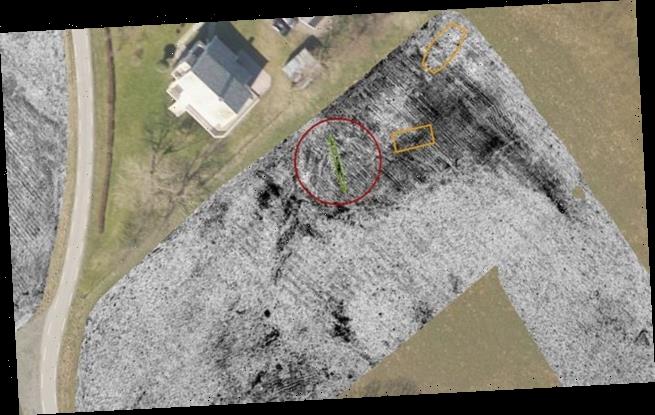Thousand-year-old Viking ship is discovered under an ancient burial ground on a tiny Norwegian island after being spotted by archaeologists using geo-radar
- Experts used geo-radar techniques to find the ship under the soil near a church
- It was found on the island of Edoeya in Norway – 70miles west of Trondheim
- The ship is thought to be about 56ft long with a 43ft long keel the team say
- There are no current plans to dig the 1,000 year old ship out of the ground
The outline of what is thought to be a 1,000 year old Viking ship has been found buried under what would have been ancient burial ground in Norway.
It was discovered using geo-radar rather than by digging into the soil and was found near a church on the island of Edoeya – 70 miles west of Trondheim.
The ship is thought to be about 56ft long with a 43ft long keel and parts of the fore and aft sterns have been destroyed.
It was first discovered in September 2019 and archaeologists say there are no current plans to dig it out of the ground.
The outline of what is thought to be a 1,000 year old Viking ship has been found buried under the soil of a field on the island of Edoey in Norway
The ship is an ‘unusual and exciting’ find, according to Knut Paasche, Head of the Department of Digital Archaeology at NIKU, and an expert on Viking ships.
‘We only know of three well-preserved Viking ship burials in Norway, and these were excavated a long time ago.
‘This new ship will certainly be of great historical significance and it will add to our knowledge as it can be investigated with modern means of archaeology.’
It was discovered using geo-radar rather than by digging into the soil and was found near a church on the island of Edoeya – 70 miles west of Trondheim
The remains of the ship are located in an area where there would previously have been a burial mound that was about 18ft around
The remains of the ship are located in an area where there would previously have been a burial mound. Experts say the mound would have had an 18ft diameter.
Using geo-radar technology, archaeologists say they can see the 43ft long keel, and hints of the first two strakes, or planks, on each side of the keel.
Based on earlier discoveries using geo-radar, including one from 2018, the team estimate the full ship would be about 56ft.
It is likely that it is the traces of the central parts of the ship that are now visible through the geo-radar images, while the fore and aft sterns appear to have been destroyed by the plough, says Dr Paasche.
‘It is too early to say anything certain about the age for the ship, but the ship must be from the Merovingian or Viking Period. Which means the ship is more than 1,000 years old.’
The team didn’t just discover a ship on the site. Archaeologists also saw traces of settlements but say it is too early to say when it would have been active
It is likely that it is the traces of the central parts of the ship that are now visible through the geo-radar images, while the fore and aft sterns appear to have been destroyed
The team didn’t just discover a ship on the site. Archaeologists also saw traces of settlements but say it is too early to say when they came from.
They started the search in September 2018 with geo-radar surveys at Edøy Church on Edoeya island.
They saw some suggestion of a find and so went back in September 2019 to expand the search. It was the later search that led to the discovery of the ship.
The team from the Norwegian Institute for Cultural Heritage Research say they hope to work with local authorities to conduct larger studies throughout Norway using non-invasive methods such as geo-radar.
It is too early to say anything certain about the age for the ship, but the ship must be from the Merovingian or Viking Period. Which means the ship is more than 1,000 years old. It was discovered under the top soil of a field as seen here b y the red circle
WHO WERE THE VIKINGS?
The Viking age in European history was from about 700 to 1100 AD.
During this period many Vikings left their homelands in Scandinavia and travelled by longboat to other countries, like Britain and Ireland.
When the people of Britain first saw the Viking longboats they came down to the shore to welcome them.
However, the Vikings fought the local people, stealing from churches and burning buildings to the ground.
The people of Britain called the invaders ‘Danes’, but they came from Norway and Sweden as well as Denmark.
The name ‘Viking’ comes from a language called ‘Old Norse’ and means ‘a pirate raid’.
The first Viking raid recorded in the Anglo-Saxon Chronicle was around 787 AD.
It was the start of a fierce struggle between the Anglo-Saxons and the Vikings.
Source: Read Full Article






